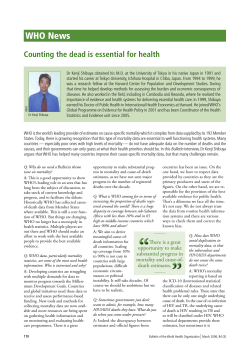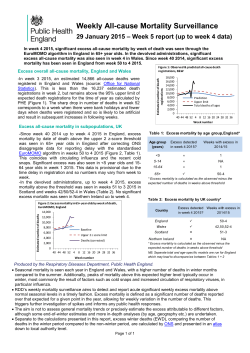
Mortality assumptions in benefit obligations— mortality tables
No. US2014-18 October 21, 2014 Mortality assumptions in benefit obligations— Society of Actuaries expected to issue new mortality tables What’s happening? At a glance New mortality tables could significantly impact pension and OPEB obligations for this yearend. The Society of Actuaries (SOA) is expected to finalize a new set of mortality tables by the end of October 2014. Because mortality is a key assumption in developing actuarial estimates, this could significantly impact the valuation of pension and other postretirement benefit (OPEB) obligations. Companies should consider this new mortality data at their plans’ next measurement date in relation to their plan participant population, historical plan-specific mortality experience, and future expectations. Key assumption Expected mortality is a key assumption in an employer's measurement of its pension and OPEB obligations. The accounting guidance does not prescribe the use of a specific mortality table or mortality improvement scale. As with all actuarial assumptions, the mortality assumption should represent management's best estimate of the expected duration of future benefit payments at the measurement date. The estimate should be based on the specific demographics and other relevant facts and circumstances for each plan and consider all relevant information available at the measurement date. Expected new mortality tables and improvement scale In February 2014, the SOA published exposure drafts of a new set of mortality tables (RP-2014) and a related, new, two-dimensional mortality improvement scale (MP-2014). The public comment period on the RP-2014 and MP-2014 exposure drafts ended on May 31, 2014. The SOA anticipates issuing final tables shortly. As currently presented, the new tables reflect longer life expectancy than projected by past tables, which could result in higher benefit obligations. Why is this important? For companies with significant defined benefit pension and OPEB obligations, longer life expectances could significantly increase the reported value of those obligations. And, for companies that immediately recognize the impact of changes in actuarial assumptions at the measurement date, that improved mortality experience could have a significant impact on fourth quarter results of operations. Companies should consider this new mortality data for their plans’ next measurement date in relation to their plan-specific mortality experience and future expectations. With regard to internal control over financial reporting, they should document how the new tables were considered. National Professional Services Group | CFOdirect Network – www.cfodirect.pwc.com In brief 1 What's next? Companies should discuss the new tables and how they compare to their plans’ mortality experience and future expectations with their actuaries, which can take some time. Companies should monitor the issuance of the final tables by the Society of Actuaries and begin determining the implications and working with their actuaries promptly. Questions? Authored by: PwC clients who have questions about this In brief should contact their engagement partner. Engagement teams who have questions should contact the Compensation team in the National Professional Services Group (1-973-236-7802). Jay Seliber Partner Phone: 1-973-236-7277 Email: jay.seliber@us.pwc.com Gina Klein Director Phone: 1-973-236-4938 Email: gina.m.klein@us.pwc.com © 2014 PricewaterhouseCoopers LLP, a Delaware limited liability partnership. All rights reserved. PwC refers to the United States member firm, and may sometimes refer to the PwC network. Each member firm is a separate legal entity. Please see www.pwc.com/structure for further details. This content is for general information purposes only, and should not be used as a substitute for consultation with professional advisors. To access additional content on financial reporting issues, visit www.cfodirect.pwc.com, PwC’s online resource for financial executives.
© Copyright 2025





















